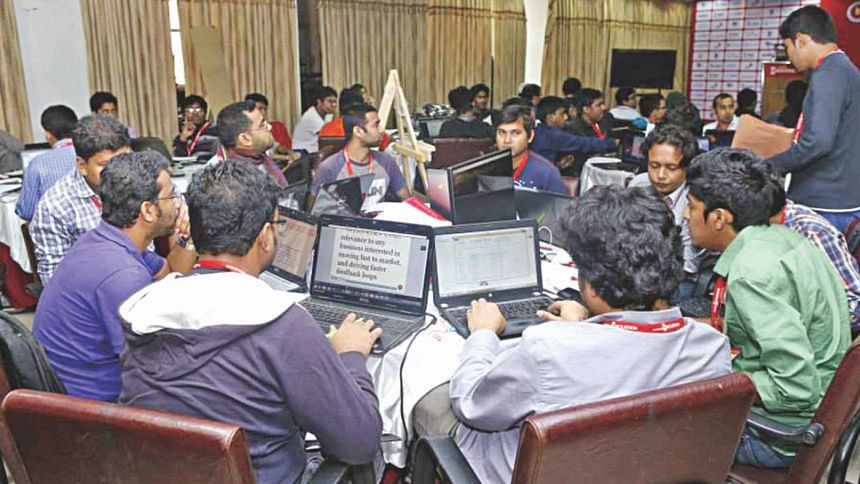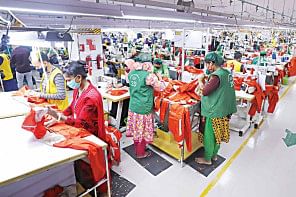Towards Digital Bangladesh

On January 12, 2014, the present government has elapsed one more year towards the destination of Digital Bangladesh. Though one year is not enough for a great leap in progress, I believe, within a year we could initiate a lot of things which would help us to materialise the Digital Bangladesh. I would like to depict a brief picture of the achievements of the ICT sector in 2014 and our initiation and attempts for achieving Digital Bangladesh in the last year.
Tele-density is an effective measure for calculating the progress of the ICT sector. In Bangladesh, mobile phone penetration and internet penetration got an accelerated momentum in 2014. On December 2013, the number of mobile phone users was 11 crore 38 lakhs which has increased to 11 crore and 98 lacs within a year. In the same time, the number of internet users has increased to 43 million from 35 million, which indicates a positive trend to the walk of Digital Bangladesh. The growing demand of mobile phone and internet is the outcome of launching of 3G network. The demand of bandwidth is also growing in time after the commencement of 3G networks for mobile phone operators. Realising the upward bound instinct of data usage, we came to an agreement with the SEE-ME-WE-5 consortium for getting the second sub-marine cable connection. Hopefully, Bangladesh could be able to connect to the cable within the first quarter of 2016.
At present, mobile applications is a popular platform for availing services and keeping this in mind, we have inaugurated 25 apps of the 100 selected that the government is planning to release on selected services provided by various ministries, divisions and directorates. Besides, as part of disseminating public services to the people through smartphones, the government has decided to develop another 500 applications. The ICT division in collaboration with a private company will develop the applications and an agreement has already been signed on August 2014 to this effect. To solve the 10 major problems of the citizens with the help of IT, the ICT Division organised the National Mobile Hackathon competition, the biggest ever hackathon in Bangladesh. Some 1,700 programmers, students, freelancers and professional app developers participated in the competition who were divided into 340 groups and from that gathering, 10 IT-based solutions were selected.
To create skilled manpower in the IT and ITES sector, Hi-Tech Park Authority has selected 100 IT graduates for delivering advanced training on Java and now they are under training at the Infosys Technologies Limited at Mohishore of India. Under the Leveraging ICT for Growth, Employment and Governance (known as LICT) programme, we have offered training to the 34,000 youngsters in which 20,000 are getting foundation training, 10,000 are receiving trade related IT Top-Up skill training and the remaining 4,000 are availing Fast Track Future Leader training with the aim to lead the IT industry in the near future. On the other side, we are going to provide freelancing training to 55,000 youngsters under the Learning and Earning project for making them capable of earning foreign currency as well as to generate self-employment. It's a matter of pride that Bangladesh ranked third in the online market place o'DESK and 13th in Elance (combined position is seven). Through freelancing, Bangladesh earned USD 21 million from the o'Desk and Elance in the last fiscal year. The Bari Boshe Barolok programme, implemented to create another 14,420 women freelancers, started in March 2014 and came to an end in February 2014.
Without developing the ICT backbone, it is quite impossible to create a Digital Bangladesh. For uplifting the infrastructure, we have connected 18,132 government offices up to the upazila level under the Info Sarkar and Bangla Gov Net programmes. 31 kilometres of fibre-optic cable connection has been imbedded from the Bangladesh Computer Council to the Bangladesh Secretariat and Bangladesh Secretariat has also come under the free WiFi coverage so that the officials could speed up their administrative works. Moreover, for a sustainable industrial growth of ICT, Hi-Tech Park is a crucial element and we are on the verge of a contract to appoint a developer in the Kaliakoir Hi-Tech Park. Furthermore, for generating dexterous manpower, ECNEC approved the bill of Establishment of Digital University at the premise of Kaliakoir Hi-Tech Park.
To make our school-going generation competent for the 21st century, we have installed modern laboratories in 3,500 schools across the country. The number of Union Digital Centres (UDCs) has expanded from 4517 to 5,275 and now, the people from remotest part of the country are receiving 200 public services through those UDCs. On June 23, 2014, Bangladesh launched the National Web Portal, the largest Government web portal in the world which contains 25 thousand websites. Mr Sajeeb Wajed Joy, ICT Affairs Advisor to the Prime Minister, inaugurated the National Portal.
Through the relentless initiatives of the ICT Division and the co-operation of private organisations, especially the trade and expertise bodies of ICT sectors such as BASIS, BCS, BACCO, ISPAB etc. we have crossed a remarkable path and hence, Bangladesh acquired some international rewards and recognitions. Prime Minister Sheikh Hasina was nominated for the 'South-South Cooperation Visionary Award 2014' for her noteworthy role in advancing Bangladesh towards a digital system and expansion of education. For bringing fundamental changes in providing services to 'Citizen's Doorstep' in the pursuit of eGovernance, on June 2014, the Prime Minister's Office of Bangladesh was awarded the prestigious 'World Summit on Information Society 2014' prize at the WSIS+10 High-Level Event of ITU at Geneva. In addition, Bangladesh was awarded the 'Global ICT Excellence Award 2014' for its outstanding contribution in social development of the nation by using ICT.
The world is changing at a tremendous pace and the tool for changing the world is Information Technology. To keep Bangladesh in this track, the Prime Minister has declared Vision 2021 in 2008. Under her visionary and time-befitting leadership, Bangladesh has achieved noticeable progress towards the implementation of Digital Bangladesh in the last six years. I am confident that country will be able to transform itself into the Digital Bangladesh envisioned within 2021.
..............................................................
The writer is State Minister, ICT division, Ministry of Posts and Telecommunication

 For all latest news, follow The Daily Star's Google News channel.
For all latest news, follow The Daily Star's Google News channel. 



Comments